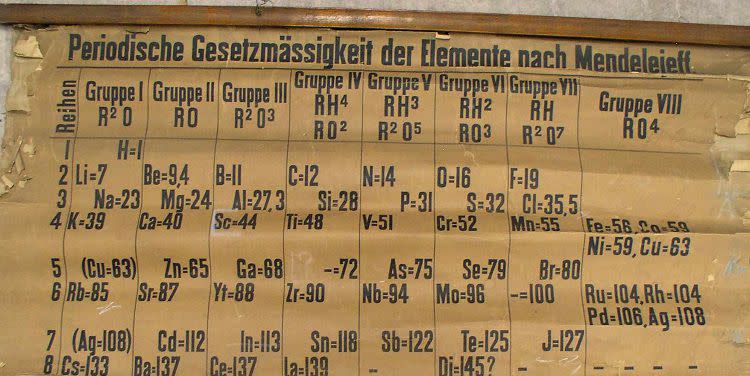World's Oldest Periodic Table Found in Storage

The oldest known periodic table in world has been discovered at the University of St Andrews. Dated back to 1885, the table was created only 16 years after Russian chemist Dmitri Mendeleev introduced the concept in 1869.
Discovered by chemistry professor Alan Aiken in 2014, the historic document had apparently been left in a storage area. Aiken was cleaning out unneeded chemicals and outdated supplies when he discovered the chart, which apparently had been there since 1968. Not maintained with the safety an older document would need, it was rolled up and forgotten. Unsurprisingly, the document is extremely fragile and flaked when first handled.
The 1860s, when the periodic table was conceived, were an exciting time for science. Approximately one new element was being discovered a year. Scientists devised a number of ways to organize these new discoveries. French geologist Alexandre-Emile Béguyer de Chancourtois attempted to create a three dimensional cylinder that worked when wrapped around a pole, British chemist John Newlands tried to compare the elements to the musical scale.
Legend has it that Mendeleev arranged the elements using the style of card game solitaire, finding matches and arranging them by weight. True or not, Mendeleev's table stuck in the scientific community for several reasons, including that it allowed room for future discoveries. There's also a pure visual simplicity to his system that others before it lacked.
By 1871, when Mendeleev released an improved version of his chart that appeared closer to what it is today, it was approaching the position of scientific standard. The St. Andrews chart resembles this second version with slight differences. Annotated in German, it reads "Verlag v. Lenoir & Forster, Wien" in the bottom lefthand corner-the name of a German scientific publisher at the time operating out of Vienna between 1875 and 1888.
The table itself also provides historic evidence on when it was produced. According to Eric Scerri, an expert on the history of the periodic table based at the University of California, Los Angeles, the chart can be dated back to a time period between 1879 and 1886. Gallium and scandium, for example, were both discovered in the 1870s. Germanium, an element predicted by Mendeleev that was discovered in 1886, is absent.
The chart found its way to St. Andrews on a predictable mission: to help a professor teach chemistry. Archivists believe that a professor Thomas Purdie purchased the chart from its German printers in 1885 for 3 marks and received it in 1888.
Now that it has been discovered, the table will receive some sorely needed tender care. It will be washed in deionized water adjusted to a neutral pH with calcium hydroxide to remove the soluble discoloration and its acidity, carefully brushed to remove loose surface debris, repaired with Japanese kozo paper, and in general be given the 5-star treatment a document of it historicity deserves.
"The discovery of the world’s oldest classroom periodic table at the University of St Andrews is remarkable," says David O’Hagan, recent ex-Head of Chemistry at the University of St Andrews in a press statement. "The table will be available for research and display at the University and we have a number of events planned in 2019, which has been designated international year of the periodic table by the United Nations, to coincide with the 150th anniversary of the table’s creation by Dmitri Mendeleev.”
Source: St Andrews
('You Might Also Like',)

